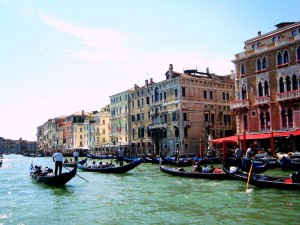There is a flowing entity which separates Boston proper from Cambridge, Massachusetts, known as “The Charles.” Each year in late summer, while strolling along, I find myself enamored by the sailboats that cluster like clouds in the sky, only to be interrupted by a set of rowers that hum by like a ray from the sun. Soon October will come, and the sailboats will disperse, as patrons eagerly anticipate the renowned Charles Regatta, as the river now belongs only to those who row crew. In a few short months, the Harvard-Yale Regatta (also known as “The Race”), the oldest collegiate athletic competition in America, will follow.
As the coxswain’s voice shouts “heads up, eyes forward,” the lead oarsman restlessly leaves the sweat dripping from his brow, drenching the collar of his white shirt, worn under the crimson jersey. They are in the home stretch now, all sixteen arms continue in unison with a machine-like perfection; they have no time to look back at their competitor, as the Bulldogs are truly only feet away. In the final pushes, the bell tolls, and in an effervescent release, the synchronicity is broken as cheers, regalia, and applause meet the heavy heavers. Harvard has won the 147th regatta against Yale.
While we here pride ourselves on our tradition of the regatta, the true ancestry belongs to Venice. Regatta, literally translated from the Venetian dialect as a “contention for mastery,” comes from the word “regattare,” literally meaning “to compete.” The regatta has been traced back to the 1650s, with the first gondola races in the Grand Canal of Venice, also known as the Canalasso, though some sources claim an even older ancestry, taking place under the rule of il doge Giovanni Soranzo on January 10th, 1315. Established in order to rejoice triumphant military conquests or to pay tribute to foreign diplomats, today, the tradition of the regatta continues in Venice on the first Sunday of each September. The Historical Regatta of Venice is a sight to see: Divided into first, a parade, followed by a boat race, thousands of locals and tourists crowd into the building balconies which line the Canal della Guidecca, or fill the stands of St. Mark’s Square, specially set up for the occasion. The Bissone, ornamentally decorated boats resembling those used in ancient warship, and Venetian rowboats establish the parade procession. Historically, the regatta was open to all within the Serenissima Republic. Also known as the “Most Serene Republic,” the Republic of Venice, which persisted for over a millennium until the year 1797, is thought to have held the annual regatta in order to honour Caterina Cornaro, Queen of Cyprus, whose presence in Venice highlighted the colonization of the Mediterranean Islands.
Today, only Venetian rowers participate in the regatta. Starting at the Riva degli Schiavoni, to the Punta della Salute, where one can see the first boats entering the Grand Canal, rowers turn at the train station, making their way back down the Grand Canal to the Machina, where celebrations await. The first race, starting at 5pm, challenges young males to row to Ca´ Foscari on one or two-oared pupparini, nine-meter long boats which were once styled for military surveillance. Next is the Women’s race, generally using a light, twin-oared boat originally used to carry ladies in waiting. The name of the boat, a mascarete, originates from the tradition of the ladies entering the boat with masks, the noses of which resemble the boat. Following up third is the Men’s race, using the six-oared caorline, a heavy transportation boat originating from the town of Caorle. Highlighting the event is the Gondolini race: Similar to the gondola, a flat-bottomed rowing boat, the twin-oared gondolini are much slimmer, allowing for speed. The Machina, a floating pontoon is where winners placed first are given red flags, in place of medals, followed by white, green and blue flags, respectively, marks the finish line.
Whether viewing from the Charles or the Canalasso, the regatta has made its way around the globe as one of the most prestigious and privileged races, which will undoubtedly continue to be cherished for centuries to come.
Published in: VIVO Magazine

